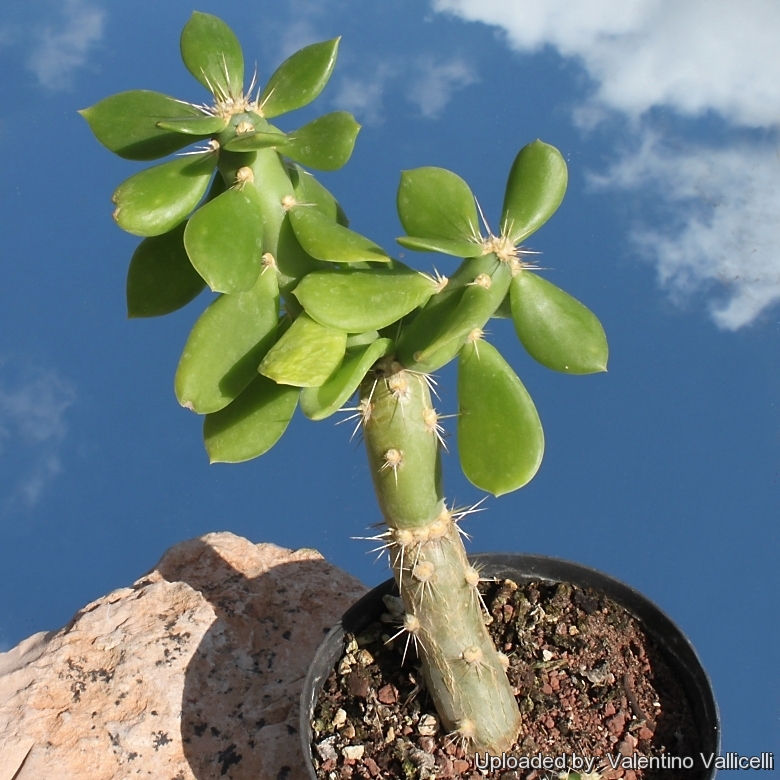Accepted Scientific Name: Quiabentia verticillata (Vaupel) Vaupel ex A.Berger
Kakteen (Berger) 46 46 1929 [Et : Borg in Cacti 53 1937.) (A.Berger)

Quiabentia pflanzii Photo by: Valentino Vallicelli
Origin and Habitat: Paraguay and Bolivia (Western South America, Southern America).
Habitat: Typically spiny plant of the western Chaco's dense understory.
Synonyms:
See all synonyms of Quiabentia verticillata
back
Accepted name in llifle Database:Quiabentia verticillata (Vaupel) Vaupel ex A.BergerKakteen (Berger) 46 46 1929 [Et : Borg in Cacti 53 1937.)Synonymy: 8
back
Common Names include:
PORTUGUESE (Português): Quiavento
SPANISH (Español): Sacharosa, Sacha rosa
Description: Quiabentia pflanziiSN|19004]]SN|19007]] is a form of Quiabentia verticillataSN|19007]]SN|19004]], but not sufficiently differentiated and considered merely a local variant of the latter (if not the same). It is a large tree or shrubs, with fleshy, cylindrical stems and oval leaves rather straggly in habit, which may reach a height of 4 to 12 (-15) m tall in nature. Looks like a combination of a giant jade plant (Crassula ovataSN|18609]]SN|18609]]) and a cactus merged into one awesome tree with soft, bright green succulent leaves. Quiabentias grow so profusely in south-eastern Bolivia that they create their own forests. Because of their shiny leaves, a summer rainstorm makes the entire forest a dazzling sight, but people used to walk down the hills of the dry Chaco fear these trees because of the very dangerous falling twigs with long thorns; quiabentias have the most painful spines of all cacti.
Derivation of specific name: the species was dedicated to Karl Pflanz who discovered it in Bolivia.
Branches: Up to 4 cm in diameter with whorls of thinner branches at apex.
Areoles: White and circular.
Leaves: Fleshy, shiny, much thicker and broader than those of other opuntias, oval to diamond-shaped with pointed ends narrowed at the base, 4 cm long and 2 cm broad.
Spines: White, short and slender, pointing downward, up to 4 cm long.
Flower: Pale red.
Subspecies, varieties, forms and cultivars of plants belonging to the Quiabentia verticillata group
 Quiabentia pflanzii (Vaupel) Vaupel ex A.Berger: A tree or shrubs, with fleshy, cylindrical stems and oval leaves rather straggly in habit, 4 to 12 (-15) m tall. Distribution: Paraguay and Bolivia.
Quiabentia pflanzii (Vaupel) Vaupel ex A.Berger: A tree or shrubs, with fleshy, cylindrical stems and oval leaves rather straggly in habit, 4 to 12 (-15) m tall. Distribution: Paraguay and Bolivia. Quiabentia verticillata (Vaupel) Vaupel ex A.Berger: is a treelike or shrubby plant 2 to 15 metres high with a distinct trunk. Stems branching off from the ends (verticillate). Distribution: Bolivia, Paraguay, and Argentina.
Quiabentia verticillata (Vaupel) Vaupel ex A.Berger: is a treelike or shrubby plant 2 to 15 metres high with a distinct trunk. Stems branching off from the ends (verticillate). Distribution: Bolivia, Paraguay, and Argentina.
Bibliography: Major references and further lectures
1) Quiabentia pflanzii in: La Revista crítica, Volumi 1-5 Grupo Editor, 1989
2) Mauseth, J., Kiesling, R., Ostolaza, C., “A Cactus Odyssey: Journeys in the Wilds of Bolivia, Peru, and Argentina”, Timber Press, USA, 2002
3) Margaret J. Martin, Peter Richard Chapman, Hugh Ambrose Auger “Cacti and their cultivation” Scribner's, 1975
 Quiabentia pflanzii Photo by: Valentino Vallicelli
Quiabentia pflanzii Photo by: Valentino Vallicelli Quiabentia pflanzii Photo by: Valentino Vallicelli
Quiabentia pflanzii Photo by: Valentino VallicelliCultivation and Propagation: Quiabentia pflanziiSN|19007]]SN|19007]] is a low maintenance plant that tolerate considerable neglect and will naturalize, it is drought-tolerant; and suitable for xeriscaping, but their spines are so painful it is difficult to recommend them for home gardens. Easy to cultivate outdoor in dry, sandy or gravely, well-drained soils. May be grown in clay soils as long as drainage is good and soils do not remain wet, it is very adaptable both in acid, neutral and basic (alkaline) soils, but prefers a pH in the range 6 to 7.5.
Watering needs: Outdoors little or no water once established, in the green house irrigate regularly from March to October, keep fairly dry in winter, tolerate dry condition but suffer if exposed to prolonged and severe drought. A position at the base of a south-facing wall or somewhere that can be protected from winter rain is best for this plant, but is however resistant to moisture and rain.
Sun Exposure: Full sun (only), in semi shaded position wont produce many flowers.
Frost hardiness: They are not cold hardy, but may survived mild frosts if very dry.
Traditional uses: The leaves can satisfy the thirst in case of lack of water.
Propagation: Propagated by cuttings of segments at any time in the growing season. (Allow cut surface to callus over before planting).












